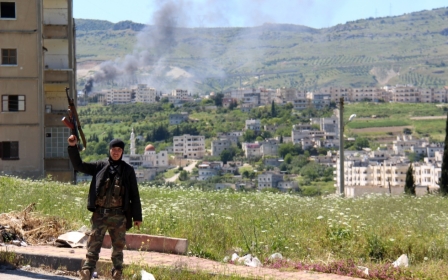An imperfect Syrian peace plan - or the apocalypse

If you ask anyone familiar with the Syrian conflict – or indeed any Syrian - you will likely get the same answer; that the prospects for the country and its people are looking very bleak indeed.
General negative outlooks aside, there is, however, unanimity on the need to end this war very soon. The longer it drags on, the more destabilising and dangerous it becomes to the region and the wider world. To that end, there has been a lot of talk and grand statements in the past, as well as several largely abortive attempts at a peace process, none of which ever amounted to very much.
It appears, though, that this time, the world might finally be getting serious. The latest, so-called Geneva 3 talks, show far more promise than their predecessor. Crucially, if belatedly, Iran, one of the major players in the conflict, was invited to participate. This may be the result of a belief that Iran is back in the global fold and open to negotiation on critical global matters of security, as demonstrated by the framework nuclear agreement.
But it might also be a realisation, born of real world pragmatism, that excluding the power which wields the most financial and military influence over the Syrian regime is not conducive to any meaningful dialogue or peace process. There is also a trend away from a hardline view, held by the majority of the Syrian opposition and their backers, that Assad should step down as a precondition to any talks. Essentially, this is tantamount to demanding the unconditional surrender of the Syrian regime and the complete handover of power, almost unheard of historically except in the aftermath of a devastating military defeat. The Syrian regime may be weakened and suffering recent setbacks on the battlefield, but it is far from defeated.
The nightmare scenario
In fact, the prospect of an outright and decisive military victory by the plethora of armed factions fighting against Assad’s forces – and in some cases against each other - are extremely remote as to be negligible. Nor would that be a desirable outcome by any sensible measure, as it would almost certainly lead to a series of irreversible calamities starting with the large-scale ethnic cleansing of religious minorities and culminating in a complete collapse of the state and its fracturing into cantons ruled by rival jihadist groups and warlords. This would plunge the country - and possibly neighbouring states too - into a perpetual cycle of conflict and aggressive external military campaigns.
This nightmare scenario is what haunts most the waking thoughts and slumber of every Syrian -and anyone else who is concerned with the fate of Syria and its people - more so than the horrors of the ongoing war. Many now think it is a race against time to prevent just such a scenario, as in all likelihood, the longer the conflict drags on, the more it seems inevitable.
Compounding those fears, is the apparent global apathy, even tacit approval, over the recent takeover of the cities of Idlib and Jisr el-Shughur by a coalition of extremist groups lead by al-Nusra, the official al-Qaeda affiliate in Syria. In a world that hadn’t completely lost its bearings, this would have been cause for great alarm and concerned action. Instead, it was barely a newsworthy event. Bizarrely, the majority of the Syrian opposition celebrated and welcomed it, without the slightest hint of appreciating the irony that, should they set foot inside those newly “liberated” cities, they would likely be immediately executed by their new rulers.
All this doesn’t appear too strange, however, in light of the almost surreal events that are now taking place across this tumultuous region. A myriad of proxy conflicts and standoffs, infused with dangerously increasing sectarian polarisation and rhetoric, threaten to destabilise the Middle East beyond control and possibly plunge it into a major, large-scale conventional war. This has proven to be fertile breeding ground for extremist jihadi groups, and has precipitated the cancerous, seemingly unstoppable growth of the Islamic State group (IS) into many Arab nations, both openly and secretly.
Yemen is the latest theatre in the region’s ongoing tragedy, and a hint of the future to come as panicky Arabian Gulf states, bolstered by billions in defense spending, unleashed a largely futile and ill-planned military campaign against what they perceive as Iranian encroachment in their backyard. Like Syria, Yemen is now being used by rival regional powers to settle scores and compete for hegemony, the victims being those nation’s hapless people who pay with their lives and have little to gain from any outcome.
This new gung-ho militarism is sweeping the region, and the apparent willingness of major global powers to not only see it continue, but also take sides and reap the bountiful windfall from billions in weapon sales is a bad omen indeed, and a forewarning of yet more conflict and escalation, not peace.
Public, private pessimism
Against this backdrop, it is not too difficult to see why most Syrians are not the slightest bit optimistic about the prospects of a near end to their country’s brutal civil conflict. This is also the view expressed privately by many of those involved in UN diplomacy and initiatives on the ground, as one of them bluntly put it to me, “no [expletive] chance”.
Looking at the current landscape of the Syrian conflict, it is easy to be pessimistic, too. The country is now de facto split, and each passing day entrenches this as the new status quo, the “Balkanisation” effect.
The east is firmly IS territory and months of bombing by the US-led coalition has predictably failed to dislodge the terrorist group from any significant territory. Northern Syria is now in the process of being completely taken over by al-Qaeda aligned groups, in what promises to be a repeat of what occurred in the east. The south is the domain of semi-tribal rebel units of varying allegiances, while the regime retains the coast, the capital and most of the centre. The demographics of the population have changed, and will continue to do so as more land falls out of central state control and into lawlessness or jihadist hands. Syrian society is now extremely polarised, mostly along sectarian lines.
There is an almost total displacement of Christians, Shiites, Alawis and other religious minorities into regime-controlled areas, while regions under the control of the various insurgent groups are almost exclusively Sunni, as is the makeup of those groups. The only exceptions to this rule are the Kurdish-controlled cantons in the north, but they are landlocked, incongruous and surrounded by hostile forces so it is difficult to see how they will become viable and autonomous. Hasakeh is the only region of Syria outside regime control which retains a sizable Christian presence, but that ancient Assyrian community has been forced to fend for itself and take up arms along with Kurdish factions against the relentless IS onslaught.
Even if, through some sort of miracle, a political agreement in Syria is reached, it will be next to impossible to reverse this fragmentation, at least not in the foreseeable future. Groups like IS and the various jihadi and al-Qaeda affiliates are not interested in any talks or process which does not involve violence, fighting until victory and the establishment of an extremist Islamic theocracy. It is, therefore, inconceivable that they would ever be part of any power-sharing government born of a peace process. Such a transitional authority will not have the necessary manpower or resources to defeat them, rendering the vast territories they control and their populations in limbo and outside state control.
As the Syrian regime weakens, the institutions with which it is organically linked and which provide, for the time being, the only coherent structure necessary for the continuation of the Syrian state – namely the Syrian army and the central government - begin to falter and teeter on the brink of collapse. If this happens, there will be nobody to negotiate anything with in the first place.
The state is already perilously weak, as the increasing influence from local irregular militias as well as foreign paramilitary groups and governments over central decision-making and governance erode state power. Economic chaos, a devastated infrastructure, rampant corruption and widespread abuses by loyalist militias are exacerbating an already precarious situation in regime-controlled areas.
Policy prescription
A sensible policy on Syria, which would salvage what is left of the country and prevent a total meltdown, would first push for immediate and wide-reaching ceasefires, and a power-sharing arrangement which keeps most of the regime and its military power structure intact, but lets a wide array of opposition figures take leading roles in vital state ministries.
Let’s not delude ourselves here: this will only ever be achieved through the outright agreement of the regional backers of the major warring camps. But those regional powers, Iran and the GCC states, are locked into their own deadly standoffs elsewhere.
The short-term goal then is stabilisation, humanitarian relief and a rolling back of the influence of warlords and paramilitaries over Syrian society. The next phase would be combating the jihadi groups with considerable outside assistance with their eradication as the ultimate aim.
For those concerned with regime change in Syria, it will have to be relegated to a long-term objective, which is indeed very doable, and arguably necessary for the ultimate healing and reconstitution of the nation. It is extremely important to remember that the Syrian regime currently retains a great deal of popular support despite all its shortcomings and the increasing frustration among the people in the areas it controls. This is due to the fear of the alternative, not any genuine ideological support.
An end to the conflict will take away those fears and, inevitably, the vast majority of former loyalists will start re-examining their allegiance to a regime which has brought so much loss, suffering and destruction to their lives, questioning whether it will be repeated again. Once an alternative, viable governing structure is successful in Syria, the old guard, which through corruption, nepotism, repression and brutality almost annihilated the country, will be rejected and driven out by the very same people who are keeping them in power right now.
But until this happens, Syria will continue to be a festering wound in the side of the Middle East, hemorrhaging its distressed people as they lose all hope and fling themselves into the arms of unforgiving seas. The mass exodus of Syrians out of their home land will only increase, as the world looks on with cold apathy and indifference.
- Edward Dark is MEE's Aleppo-based columnist and writes under a pseudonym.
The views expressed in this article belong to the author and do not necessarily reflect the editorial policy of Middle East Eye.
Photo: A boy rides his bike in front of destroyed buildings on 25 April in a rebel-held area of the northern Syrian city of Aleppo (AFP)
Middle East Eye propose une couverture et une analyse indépendantes et incomparables du Moyen-Orient, de l’Afrique du Nord et d’autres régions du monde. Pour en savoir plus sur la reprise de ce contenu et les frais qui s’appliquent, veuillez remplir ce formulaire [en anglais]. Pour en savoir plus sur MEE, cliquez ici [en anglais].





